Loop-mediated isothermal amplification (LAMP) is one of the most famous and popular isothermal amplification methods. Compared with the PCR non-isothermal method, LAMP can effectively amplify the speed , based on a set of up to 6 primers and a strand-displacing polymerase, capable of highly sensitive and specific amplification of target DNA. Its simplicity, rapidity, and precision make this method particularly suitable for on-site point-of-care diagnosis.
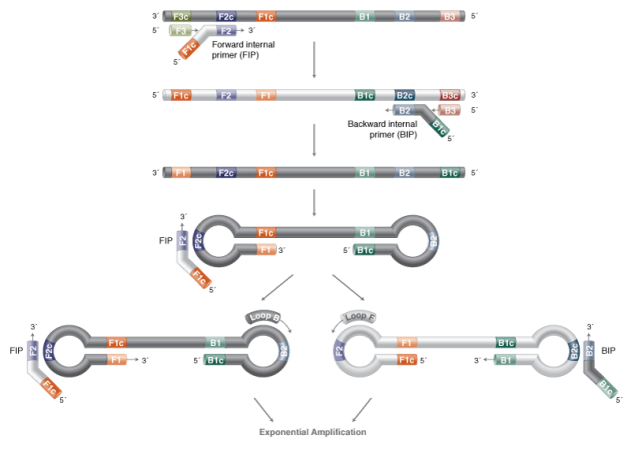
Since the start of the COVID-19 pandemic, more than 800 publications on SARS-CoV-2 detection have been published. Of these, about 100 were using LAMP as a detection method. This underscores the importance of LAMP not only for general research, but also for global social issues. In the diagnosis of infectious diseases and blood screening, molecular diagnosis based on nucleic acid amplification can shorten the 'window period' of diagnosis and can quantitatively detect pathogens. Compared with traditional immunodiagnostic methods, it has irreplaceable advantages.
The key factor of LAMP system optimization-enzyme
BST DNA polymerase
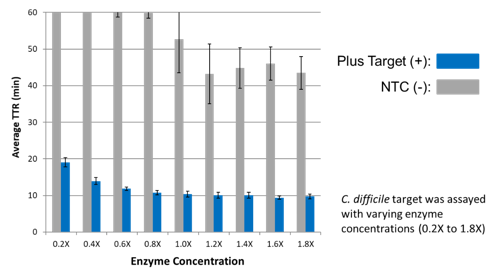
Enzyme Concentration Optimization
Enzymes, one of the key components of the LAMP system, will have an important impact on the reaction results. Optimizing the amount of enzyme can significantly improve the performance of the LAMP system: shorten the reaction time, improve specificity and sensitivity, and reduce negative background.
平LAMP核心原料酶供应
Through independent research and development and iterative optimization, the team has qualitatively improved BST DNA polymerase in terms of enzyme activity, amplification ability, yield, salt tolerance and thermal stability, which covers different high and low concentrations as well as a freeze-dried version. After rigorous quality control production, its efficiency and quality are comparable to well-known imported brands, and the perfect combination with LAMP technology can be widely used in the real-time detection of pathogens based on isothermal amplification technology.
Item No. | Product name | Specification | Application Scenario |
DE10601 | Bst DNA polymerase | Customizable | Nucleic acid isothermal amplification. Key raw materials of POCT isothermal amplification reagents. Development of isothermal amplification diagnostic kits. |
Enzyme Properties 01
· Guanidine hydrochloride resistance.
· High stability and good activity.
· Flexible reaction conditions and high salt tolerance.
· The quality is comparable to imported brands, and the delivery time is stable, effectively reducing customer costs.
Full Performance Verification Analysis 02
Single Enzyme Verification
· Optimum PH test (Tris-HCl)
The test uses the mouse GAPD gene as a template and is determined by the probe method (the same below), and the results show that the activity of BST DNA polymerase is the highest when the PH is 9.
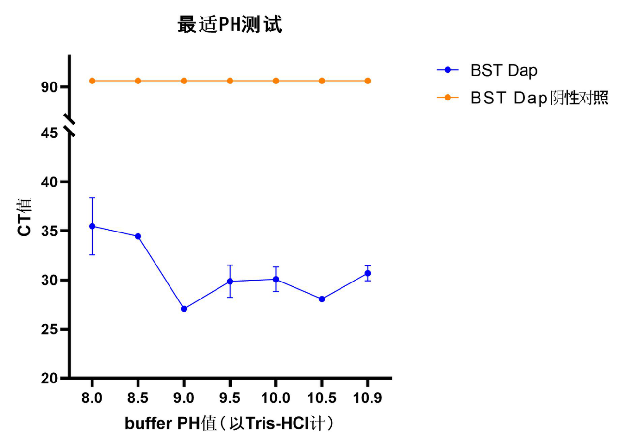
Optimum PH test
CT value
BST Dap negative control
Buffer PH level (Tris-HCl)
· Salt tolerance test (K+)
Using BST2.0 of a well-known imported brand as a comparison, under the same enzyme activity, the salt tolerance performance of Bst DNA polymerase and BST2.0 is almost the same.
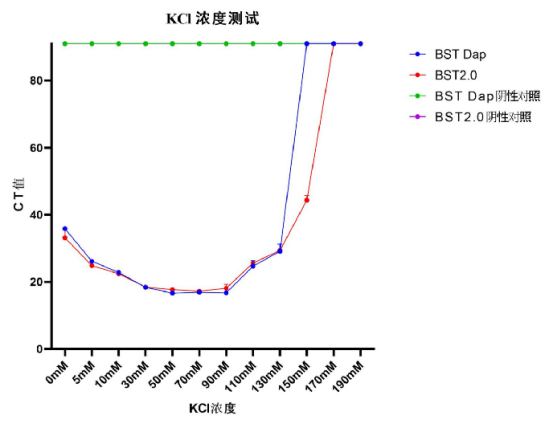
KCI concentration test
CT value
BST Dap negative control
BST2.0 negative control
KCI concentration
· Effect of protein denaturant
Using BST2.0 of a well-known imported brand as a comparison, under the same buffer and enzyme activity, Bst DNA polymerase and BST2.0 have basically the same tolerance to protein denaturants.
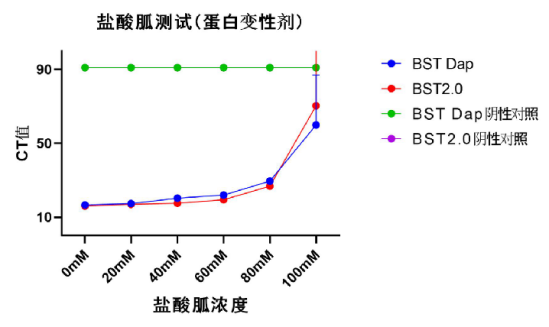
Guanidine hydrochloride test (protein denaturant)
CT value
BST Dap negative control
BST2.0 negative control
Guanidine hydrochloride concentration
Finished product verification by different methods
· SYRB Green and probe method
The effect of Bst DNA polymerase is exactly the same as that of the finished reagent.
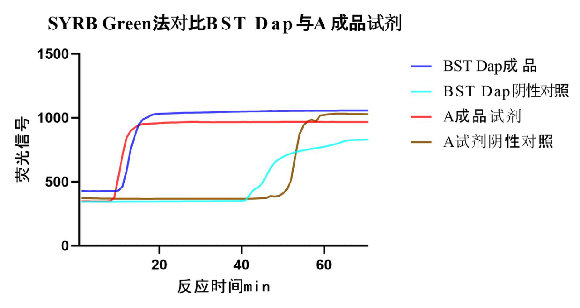
Comparison of BST Dap with A finished reagent by SYRB Green
Fluorescence signal
BST Dap finished product
BST Dap negative control
A finished reagent
A reagent negative control
Reaction time (min)
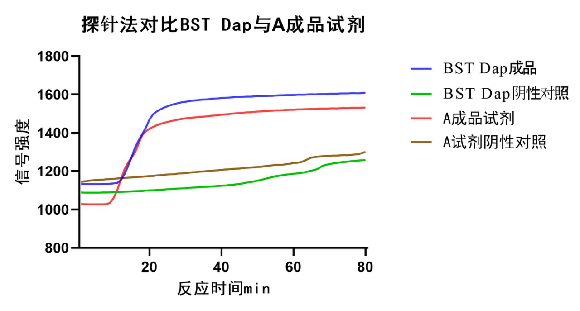
Comparison of BST Dap with A finished reagent by probe method
Signal strength
BST Dap finished product
BST Dap negative control
A finished reagent
A reagent negative control
Reaction time (min)
· Colorimetry
Bst DNA polymerase can efficiently amplify different templates, and its sensitivity is significantly better than that of A finished reagent.
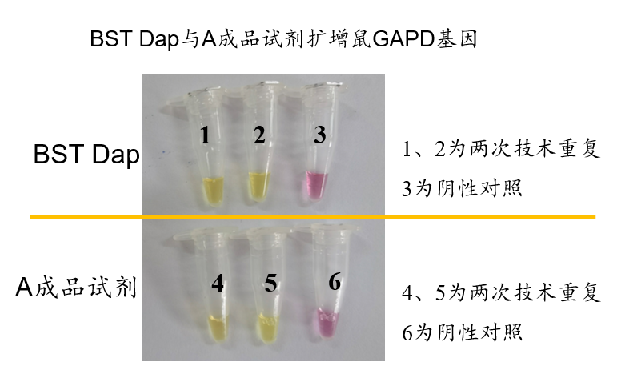
BST Dap and A finished reagents amplify GAPD gene
BST Dap
1 and 2 are two repeated tests and 3 is negative control.
A finished reagent
4 and 5 are two repeated tests and 6 is negative control.
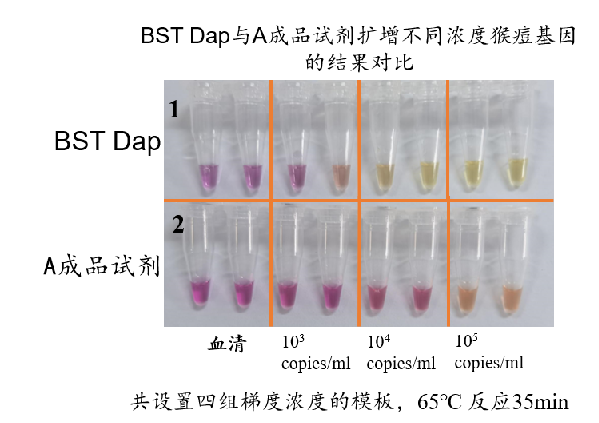
Comparison of the results of amplification of different concentrations of monkeypox gene between BST Dap and A finished reagent
A finished reagent
Serum
A total of four sets of templates with gradient concentrations were set up and reacted at 65°C for 35 minutes.